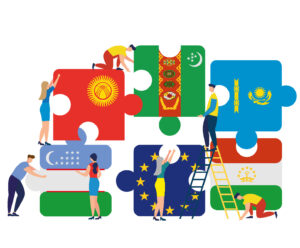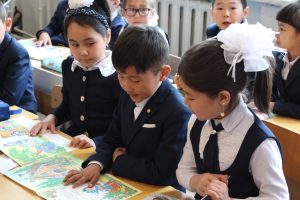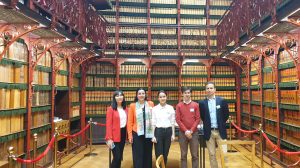Ten tasks for the new EU Special Representative to Central Asia

Download “Ten tasks for the new EU Special Representative to Central Asia”
EUCAM-Policy-Brief-24.pdf – Downloaded 414 times – 592.05 KBThe EU has a new Special Representative (EUSR) for Central Asia. It was announced on 18 June that Patricia Flor from Germany would on 1 July replace Ambassador Pierre Morel, who has been EUSR for Central Asia since 2006. Ambassador Morel has been the face of Europe in Central Asia. His work involved promoting EU energy and security interests in the region, as well as establishing close ties with leaders in Central Asia and liaising with China, Russia and the United States. He coordinated policies with the OSCE and NATO, actively engaged with expert communities in Europe and Central Asia and travelled extensively throughout the region.
The EUSR’s role in Central Asia is substantial, especially in view of the fact that there are few European national embassies in the region. The challenge for the new EUSR is one of balancing priorities. She will need to maintain contacts with the region’s authoritarian governments while at the same time engaging fully with civil society. She will have to pursue the EU’s hard security and energy interests alongside promoting democracy and human rights. And she must emphasise the importance of Central Asia in Europe while also increasing the visibility of the EU in Central Asia.
In doing all this, she will need to make sure that she acts as a ‘real European’. Germany was the mastermind behind the 2007 EU Strategy for Central Asia. It is one of the few European countries with embassies in all five Central Asian states, and it has twice as many staff in the region as the EU. Germany’s development support to Central Asia dwarfs that of any other European country. This is good news for coordination and effectiveness, but the new EUSR must ensure that European policies in Central Asia are not solely a German enterprise. The EUSR will need to work to secure buy-in and ownership of the EU Strategy by other European countries. She must convince them of the importance to Europe of Central Asia’s development.
To make her mark in Central Asia, the new EUSR should focus on ten tasks:
1. Function as an effective linchpin between the European External Action Service (EEAS), member state policies and Commission (DEVCO) funding by prioritising and coordinating limited resources. The new EUSR will need to unite political strategy, premised on values and interests, with development assistance funding, traditionally based on poverty eradication. This will enable her to pitch a clear vision for the EU on a region that is a low on the agenda but high in strategic importance.
The newly upgraded delegations of the EEAS provide an opportunity to build a more unified policy and assistance strategy from the ground up. EU Heads of Delegation, because of their dual roles, can ensure consistency between political and assistance strategies at a bilateral level, bypassing inter-institutional squabbles in Brussels. Ensuring that EEAS activities are connected to Commission funding would also help streamline the existing complex and mismatched political and funding priorities, and better communicate the EU’s purpose and agenda in the region.
Council and Commission initiatives have been developed separately and in parallel to seven regional political priorities, three regional political and funding initiatives, three (different) regional assistance priorities under a separate Commission strategy, as well as bilateral assistance priorities developed on the basis of bilateral policy strategy papers. This complicated architecture should be replaced by a workable joint policy and assistance strategy, with clear political direction. The EUSR, as the representative of the EU High Representative, is best placed to bring political interests and development policy together, as well as to help EU institutions to work effectively together.
2. Liaise closely with essential external actors in Central Asia, particularly the U.S., Russia and China, and seek to cooperate wherever possible. In preparing for the challenges that the Central Asian region will face over the coming decade, the lack of discussion between the EU, Russia and China must be addressed. Prospects for cooperation at the multilateral level with the Collective Security Treaty Organisation (CSTO) and the Shanghai Cooperation Organisation (SCO) appear limited. But bilateral dealings with Russia and China seem to be more promising for potentially developing coordinated action, or at least for creating joint discussion platforms, on the topics of regional security with Russia and of development aid with China. The EUSR will have to coordinate with both actors regularly and hopefully also build cooperation, so as to put to rest any ideas of a ‘new Great Game’.
The EU and the United States must also align their strategies in the region. Central Asians think the EU and the U.S. promote separate and sometimes even contradictory logics. Regular meetings between EU and U.S. higher representatives have gone unpublicised. This contributes to the misreading that there is a lack of coordination between the EU Strategy for Central Asia and the U.S. New Silk Road vision. Greater coordination must be put in place, especially in view of the limited funds and capabilities that the EU and the U.S. will devote to the region over the coming years.
3. Link energy security to development and bring EU structures, energy companies and Central Asian govern-ments together. The EU’s overarching energy strategy is to secure reliable, affordable and diverse long-term energy supplies and to increase its capacity to withstand sudden supply and demand shocks. For their part, the Central Asian republics are seeking to diversify transit routes and customers for their hydrocarbon exports. There is, therefore, clear mutual advantage in increased cooperation. Both sides share interests in harmonising technical standards, integrating markets, developing infrastructure and moving to more sustainable and efficient energy use. So, energy security and development are complementary objectives.
The EUSR should build confidence between Central Asian governments (mainly from Kazakhstan and Turkmenistan) and energy companies on the need for a stable investment framework in the region, encompassing predictable and fair taxation, employment and a firm commitment to business transparency and the reduction of corrupt practices. In the case of Turkmenistan – that offers interesting gas import opportunities but severe technical and values-related hurdles – the EUSR should work closely with the Commissioner for Energy. Together, they must clarify with Turkmenistan the diplomatic, commercial and technical preconditions that are needed for a deal on Ashgabat’s committing gas exports in commercial volumes to Europe. The EUSR will need to evaluate with the Commission and with European energy companies whether these conditions can be met, given the poor state of governance in Turkmenistan’s hydrocarbon sector. She must firmly establish a basis for Central Asian gas exports to reach the European market ahead of the decision expected in 2013 on which pipeline routes will transport Central Asian gas to Europe.
4. Take a lead role on water disputes as the EU’s negotiator and treat the issue as an essential security issue with serious social and development implications. The usage and allocation of water resources represents an evolving regional security stress point and a potential source of inter-state conflict, in particular between Uzbekistan and Tajikistan. The EU is engaged in some technical programmes, but its regional Water Initiative has so far had little impact. To support infrastructure and development, broader coordination is needed between the big actors and donors, such as the World Bank, the Asian Development Bank, Russia, the EU and others. The EUSR could play a larger role in the coordination of international programmes, at least among the European actors involved.
The EUSR should recognise that disputes over water have acquired a national security dimension and can no longer be viewed only through the lens of improved environmental management. The EUSR could also take on the role of impartial mediator between the Tajik and Uzbek governments in bilateral negotiations to help resolve the issue of the impact of the proposed Rogun dam project. She could help develop alternative solutions that would enhance Tajikistan’s energy security and safeguard Uzbekistan’s water needs. Meanwhile, the EUSR should work with the Commission and regional governments to establish a combined early warning, conflict prevention, contingency planning and disaster reduction mechanism that could deal with the regional security implications of conflict or environmental hazard scenarios.
5. Investigate the incorporation of Afghanistan in pro-grammes that addresses joint security and development concerns in Central Asia. In contrast to U.S. involvement in the region, the EU strategy in Central Asia is not directly related to policies and activities in Afghanistan, nor is it geared towards preparations for the situation post-2014, when NATO will have largely left Afghanistan. The EU should not align itself with the U.S.’s Afghanistan-centred strategy, but it must nonetheless coordinate its actions better in the Afghan and Central Asian regions. Bureaucratic divisions prevent this sort of coordination, except on rare occasions. This limits the EU’s capacity to act, while other regional actors and international donors are busy trying to articulate policies linking both regions.
A differentiated bilateral approach might enable the EU to pursue joint projects involving, for example, Afghanistan and Tajikistan, in a practical way. This could prevent Afghanistan’s impact on its neighbours from being interpreted exclusively in terms of negative spillover. At the regional level, Afghanistan must be increasingly integrated into multilateral activities on water management. Reinforcing the EU focus on human security could help integrate Afghanistan into current Central Asian programmes on higher education, migration management and risks of refugee flows, post-conflict mediation, rural development, and aid for small entrepreneurship. The new EUSR is well placed to lead the process of integrating EU policies on Afghanistan and Central Asia. A good start would be to organise a round of joint appearances in Brussels and visits to both regions by the new EUSR for Central Asia and the EUSR for Afghanistan, Vygaudas Usackas.
6. Advertise the need for Security Sector Reform (SSR) and look for areas of cooperation on reforming security institutions. Central Asian states have so far largely resisted SSR. Kazakhstan has developed the most robust framework for greater transparency and accountability in its security sector, but even Astana still relies on Soviet methods for the administration of its institutions of power. Kyrgyzstan and Tajikistan have tried to carry out some aspects of SSR, but the process has been very slow. In Uzbekistan and Turkmenistan, the security services are present in all aspects of everyday life. In both countries, the police and armed forces serve the interests of the autocratic leadership, protecting them from political opponents and social dissent.
Central Asian states are vulnerable to the emergence of extremist and criminal groups, and the current security sectors are not prepared to deal with these elements. The security forces are geared towards regime security rather than state security. This makes them ineffective and represents a threat to the populations of the region. SSR is, therefore, urgently needed throughout Central Asia to democratise control over the security apparatus and improve civilian oversight over the military, police, intelligence and the judicial sector. In this sense, SSR is closely linked to development and human security in Central Asia, which is a key EU objective.
SSR is a sensitive matter in Central Asia and the countries’ leaderships are unlikely to change their ways radically. But the new EUSR should bring every aspect of SSR to the table, while also looking for entry points in support of SSR. An overhaul of the intelligence communities, security forces and the army seems far-fetched for now. But there may be possibilities to promote juridical and police reform, to step up activities in border management and to make a start on raising awareness among oversight institutions such as the legislature and civil society.
7. Do not give up on democracy promotion and position the EUSR as an advocate of democratic governance. The 2007 EU Strategy said that one of the EU’s key priorities in Central Asia is promoting democratisation, the rule of law, good governance and human rights. Five years on, the EU has succeeded in setting up bilateral Human Rights Dialogues and a regional Rule of Law Initiative. But the focus of the EU’s engagement in the region has not been to endorse core democratic principles, such as genuine political pluralism, transparent and accountable government, and free and fair elections. The Central Asian political elites and the general population have somewhat sceptical attitudes towards democratic rule and misconceptions of democracy. This is mainly due to a lack of positive experiences and regular encounter with democratic practice.
Further efforts are needed to raise awareness of the benefits of democratisation, and more needs to be done to reach out to youth who are largely unfamiliar with democracy. The EUSR maintains contacts with Central Asian governments, parliaments, the judiciary and civil society. This makes her well placed to take up the task of democracy advocate. She must actively support the European Instrument for Democracy and Human Rights and also engage closely with European national embassy activities in the region.
8. Promote universal human rights as an integral part of engagement with Central Asian governments. Regular Human Rights Dialogues with all five Central Asian countries are an essential ingredient of the EU’s normative approach. The practice of regular exchanges on human rights should be applauded and supported. But this approach is not enough, since it risks detaching human rights issues from high level political dialogue. This is especially true for the bilateral dialogues of the EU Member States with the Central Asian governments, which have explicitly avoided bringing up human rights concerns. At the same time, five years on from the 2007 EU Strategy, it is clear that dialogues alone are not sufficient in improving specific human rights issues on the ground.
The EU should move from an ‘exchange of views’ to monitoring tangible progress, or the lack thereof, on human rights matters. Some confidence of Central Asian states has been won. Also the EU understands now it should be ready to offer concrete responses to Central Asian queries and requests for advice. So, discussing concrete issues does not now necessarily have to be seen as dictating demands. The EUSR could play an important role in keeping human rights on the top of the agenda in the EU and Central Asia, for instance, by transmitting EU concerns in meetings with Central Asian leaders.
9. Engage more with civil society. Regular meetings with civil society organisations in Central Asia (and Europe) will add to the EU’s credibility as an actor in Central Asia. It could help strengthen the vulnerable position of the media, NGOs, human rights activists and independent researchers in the region.
Currently, the EU in cooperation with Central Asian authorities organises Civil Society Seminars that are loosely connected to the official Human Rights Dialogues. These meetings vary in actual input and attendance from civil society. Often, agendas are developed by the EU Delegations and Central Asian governments and avoid sensitive matters. Alongside this format, the EUSR could work towards creating a regular civil society forum, along the lines of the Eastern Partnership or EU-Russia civil society forums. It could be held in Europe and could attract a variety of Central Asian and European civil society actors. The format might link up to existing OSCE formats and thus also include civil society actors from Eastern Europe, the South Caucasus, Russia and Turkey. Most importantly, such a forum would need to be easily accessible for civil society organisations from Central Asia, who should be able to join without fear of persecution at home. This would signal that the EU does not only work with governments but also engages with civil society at a regional level.
10. Provide committed and public leadership on the EU’s declared aspiration to contribute to the modernisation of Central Asian education systems. The establishment of the European Education Initiative was welcomed by Central Asian governments, which recognise the lack of educational opportunities for quickly growing new generations. However, concrete results have yet to be seen, particularly on regular policy dialogue within the framework of the Education Platform.
In order to move from rhetoric to results, stronger commitment and better coordination is needed among the various European and Central Asian actors. The further development of the Education Initiative must reflect local needs and not the EU’s own definition of priorities. This presupposes a closer engagement with domestic education actors and greater efforts to include them in the policy dialogue. In view of these concerns, one of the top priorities on the EUSR’s agenda should be revising the Education Initiative’s goals and identifying further opportunities for inter-institutional cooperation and inter-cultural exchange. As well as overhauling the EU’s initiative, the EUSR can provide a good example by visiting schools and universities in the region. This kind of effort would also have the positive side effect of increasing EU visibility.
These ten tasks are not small. They constitute a full portfolio of crucial EU interests in the region. If they are carried out well, and if democratic and human rights values can be carefully balanced with energy and security interests, the EU can succeed in further consolidating and even expanding its position in the Central Asian region, to the benefit of Central Asia and Europe alike







